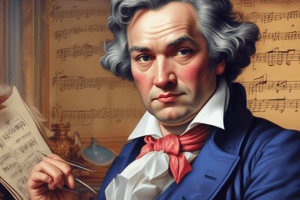Podcast
Questions and Answers
What is the Classical Period?
What is the Classical Period?
1750-1820 (1825)
Which of the following is a general characteristic of 'Classical' music? (Select all that apply)
Which of the following is a general characteristic of 'Classical' music? (Select all that apply)
- Homogenous style (correct)
- Might steal tunes (correct)
- More complex and mysterious
- Lighter and airy (correct)
What does 'classical' mean in music?
What does 'classical' mean in music?
Refers to art music from the 1750s to the early 1830s, including all Western art music from the Medieval era to the 2000s.
What is the age of Enlightenment?
What is the age of Enlightenment?
Where did the center of the music world move during the Classical Period?
Where did the center of the music world move during the Classical Period?
What city was the musical center of the Classical style?
What city was the musical center of the Classical style?
Match the following qualities of music in the Classical Period with their descriptions:
Match the following qualities of music in the Classical Period with their descriptions:
Classical-era instrumental music primarily comprised which forms? (Select all that apply)
Classical-era instrumental music primarily comprised which forms? (Select all that apply)
What is a symphony?
What is a symphony?
How many movements does a typical symphony originally have and what was the tempo of each?
How many movements does a typical symphony originally have and what was the tempo of each?
What is a concerto?
What is a concerto?
What defines chamber music?
What defines chamber music?
What is a string quartet composed of?
What is a string quartet composed of?
What is the sonata (allegro) form?
What is the sonata (allegro) form?
What is the minuet form?
What is the minuet form?
What is the rondo form?
What is the rondo form?
What is theme and variations?
What is theme and variations?
How was opera different in the Classical period compared to the Baroque? (Select all that apply)
How was opera different in the Classical period compared to the Baroque? (Select all that apply)
What is opera buffa?
What is opera buffa?
What is a coda?
What is a coda?
What is a cadenza?
What is a cadenza?
What is a scherzo?
What is a scherzo?
What is a motive in music?
What is a motive in music?
Flashcards are hidden until you start studying
Study Notes
Classical Period Overview
- Timeframe: 1750-1820 (1825)
- Focus on elegance, beauty, and structure in music composition.
Characteristics of Classical Music
- Lighter, airy, and elegant style with clear design.
- Homogenous style; emphasis on natural and pleasing variety.
- Utilization of contrast in mood and melody.
- Frequent borrowing of tunes and ideas from other works.
Definition of Classical Music
- Broadly encompasses Western art music from the Medieval era to the 2000s.
- Specifically refers to the music from the 1750s to early 1830s, characterized by Mozart and Haydn.
- Distinction made in the 19th century to differentiate from Romanticism: Classicism emphasized beauty and structure.
Intellectual Background
- Coincided with the Age of Enlightenment (or Age of Reason), emphasizing universal laws of nature and humanity.
Vienna as Cultural Hub
- Shifted from Italy to Vienna as the center of classical music in the Austrian Empire.
- Home to major composers: Haydn, Mozart, and Beethoven.
Musical Qualities in the Classical Period
- Melodies characterized by short, tuneful phrases with statement-answer patterns.
- Rhythm maintained a steady metric quality.
- Predominantly homophonic texture.
- Tonal harmony with modulations to closely related keys; continuo part was phased out.
- Dynamic levels explored with gradual crescendos and decrescendos.
- Use of orchestras, chamber music groups, and pianos (as a replacement for harpsichords).
Instrumental Forms
- Key forms include Symphony, Concerto, Chamber music, and Sonata.
Symphony
- Large multi-movement work for orchestra—marking a significant contribution of the Classical period.
- Structure typically expanded from 3 to 4 movements: fast, slow, dance-like, fast.
Concerto
- Multi-movement composition contrasting a soloist with an orchestra.
Chamber Music
- Small-scale instrumental music, generally featuring one player per part, for 2-9 musicians.
- Example groups include string quartets and flute quartets.
String Quartet Composition
- Consists of two violins, one viola, and one cello.
Sonata Form
- Structure: Exposition (presentation of themes), Development (theme manipulation), Recapitulation (return of themes), may include an introduction and coda.
Dance Forms in Classical Music
- Minuet Form: Triple meter, three-part structure (A-B-A).
- Rondo Form: Theme repeated three or more times with contrasting sections in between.
Theme and Variations
- Composition based on a theme followed by altered versions of that theme.
Opera Developments
- Transitioned from Baroque with consistent moods and mythological stories to Classical with more varied moods and everyday life stories.
- Incorporation of more vocal ensembles and fluid transitions, resulting in livelier performances.
Opera Buffa
- Comic opera genre of the 18th and 19th centuries, often contrasting with the serious opera (opera seria).
Additional Musical Concepts
- Coda: New imitative passage leading to repeated cadences.
- Cadenza: Soloist improvises or elaborates on themes during performance.
- Scherzo: Playful third movement found in some symphonies and other compositions.
- Motive: Short musical idea, essential for developing themes in compositions.
Studying That Suits You
Use AI to generate personalized quizzes and flashcards to suit your learning preferences.




